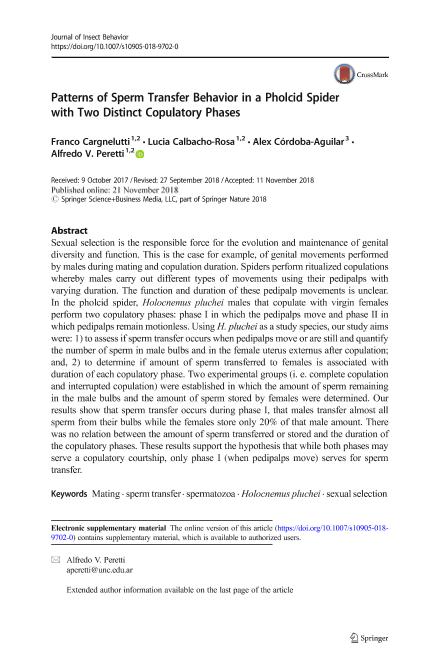Mostrar el registro sencillo del ítem
dc.contributor.author
Cargnelutti, Franco Ignacio

dc.contributor.author
Calbacho Rosa, Lucía Soledad

dc.contributor.author
Córdoba-Aguilar, Alex
dc.contributor.author
Peretti, Alfredo Vicente

dc.date.available
2019-11-12T14:34:42Z
dc.date.issued
2018-11
dc.identifier.citation
Cargnelutti, Franco Ignacio; Calbacho Rosa, Lucía Soledad; Córdoba-Aguilar, Alex; Peretti, Alfredo Vicente; Patterns of sperm transfer behavior in a pholcid spider with two distinct copulatory phases; Springer New York LLC; Journal of Insect Behaviour; 31; 6; 11-2018; 616-628
dc.identifier.issn
0892-7553
dc.identifier.uri
http://hdl.handle.net/11336/88604
dc.description.abstract
Sexual selection is the responsible force for the evolution and maintenance of genital diversity and function. This is the case for example, of genital movements performed by males during mating and copulation duration. Spiders perform ritualized copulations whereby males carry out different types of movements using their pedipalps with varying duration. The function and duration of these pedipalp movements is unclear. In the pholcid spider, Holocnemus pluchei males that copulate with virgin females perform two copulatory phases: phase I in which the pedipalps move and phase II in which pedipalps remain motionless. Using H. pluchei as a study species, our study aims were: 1) to assess if sperm transfer occurs when pedipalps move or are still and quantify the number of sperm in male bulbs and in the female uterus externus after copulation; and, 2) to determine if amount of sperm transferred to females is associated with duration of each copulatory phase. Two experimental groups (i. e. complete copulation and interrupted copulation) were established in which the amount of sperm remaining in the male bulbs and the amount of sperm stored by females were determined. Our results show that sperm transfer occurs during phase I, that males transfer almost all sperm from their bulbs while the females store only 20% of that male amount. There was no relation between the amount of sperm transferred or stored and the duration of the copulatory phases. These results support the hypothesis that while both phases may serve a copulatory courtship, only phase I (when pedipalps move) serves for sperm transfer.
dc.format
application/pdf
dc.language.iso
eng
dc.publisher
Springer New York LLC
dc.rights
info:eu-repo/semantics/openAccess
dc.rights.uri
https://creativecommons.org/licenses/by-nc-sa/2.5/ar/
dc.subject
HOLOCNEMUS PLUCHEI
dc.subject
MATING
dc.subject
SEXUAL SELECTION
dc.subject
SPERM TRANSFER
dc.subject
SPERMATOZOA
dc.subject.classification
Zoología, Ornitología, Entomología, Etología

dc.subject.classification
Ciencias Biológicas

dc.subject.classification
CIENCIAS NATURALES Y EXACTAS

dc.title
Patterns of sperm transfer behavior in a pholcid spider with two distinct copulatory phases
dc.type
info:eu-repo/semantics/article
dc.type
info:ar-repo/semantics/artículo
dc.type
info:eu-repo/semantics/publishedVersion
dc.date.updated
2019-10-16T14:29:46Z
dc.identifier.eissn
1572-8889
dc.journal.volume
31
dc.journal.number
6
dc.journal.pagination
616-628
dc.journal.pais
Estados Unidos

dc.description.fil
Fil: Cargnelutti, Franco Ignacio. Consejo Nacional de Investigaciones Científicas y Técnicas. Centro Científico Tecnológico Conicet - Córdoba. Instituto de Diversidad y Ecología Animal. Universidad Nacional de Córdoba. Facultad de Ciencias Exactas Físicas y Naturales. Instituto de Diversidad y Ecología Animal; Argentina
dc.description.fil
Fil: Calbacho Rosa, Lucía Soledad. Consejo Nacional de Investigaciones Científicas y Técnicas. Centro Científico Tecnológico Conicet - Córdoba. Instituto de Diversidad y Ecología Animal. Universidad Nacional de Córdoba. Facultad de Ciencias Exactas Físicas y Naturales. Instituto de Diversidad y Ecología Animal; Argentina
dc.description.fil
Fil: Córdoba-Aguilar, Alex. Universidad Nacional Autónoma de México; México
dc.description.fil
Fil: Peretti, Alfredo Vicente. Consejo Nacional de Investigaciones Científicas y Técnicas. Centro Científico Tecnológico Conicet - Córdoba. Instituto de Diversidad y Ecología Animal. Universidad Nacional de Córdoba. Facultad de Ciencias Exactas Físicas y Naturales. Instituto de Diversidad y Ecología Animal; Argentina
dc.journal.title
Journal of Insect Behaviour

dc.relation.alternativeid
info:eu-repo/semantics/altIdentifier/doi/http://dx.doi.org/10.1007/s10905-018-9702-0
dc.relation.alternativeid
info:eu-repo/semantics/altIdentifier/url/https://link.springer.com/article/10.1007%2Fs10905-018-9702-0
Archivos asociados
